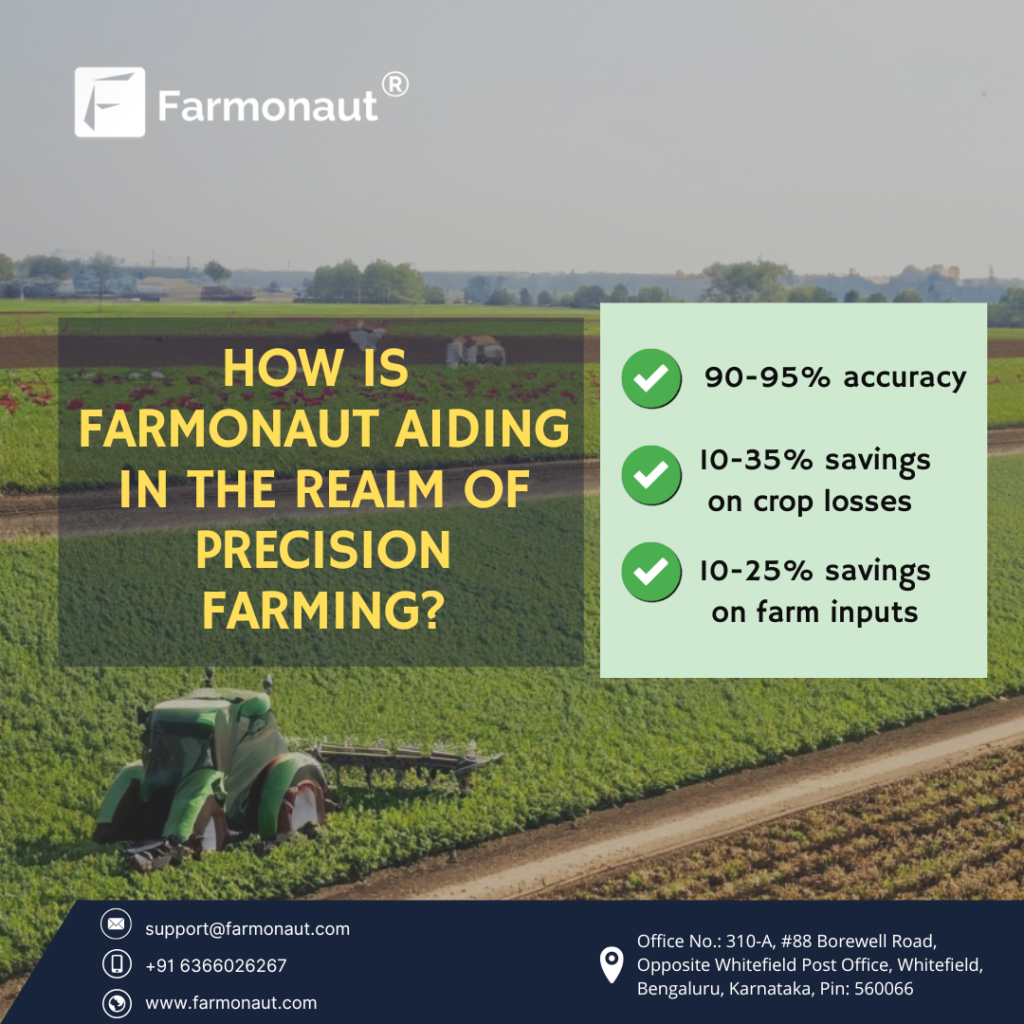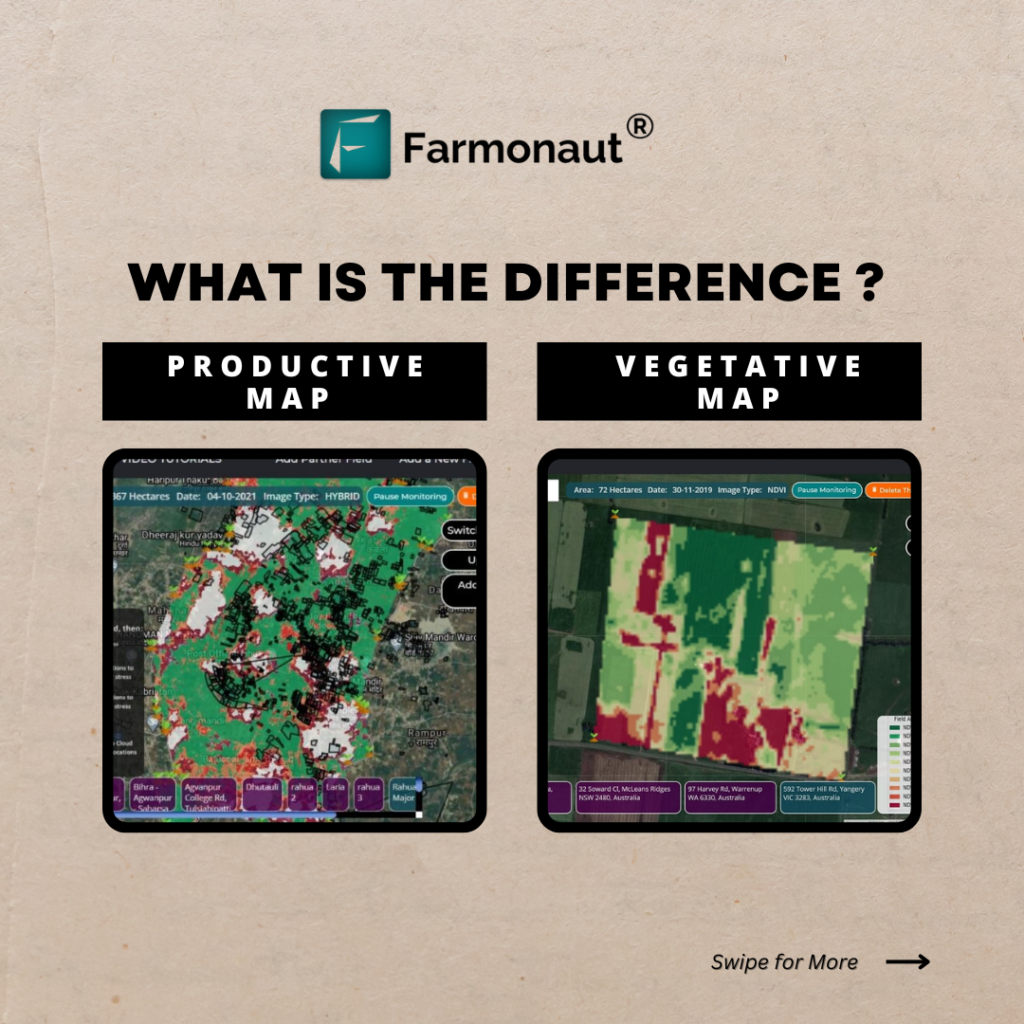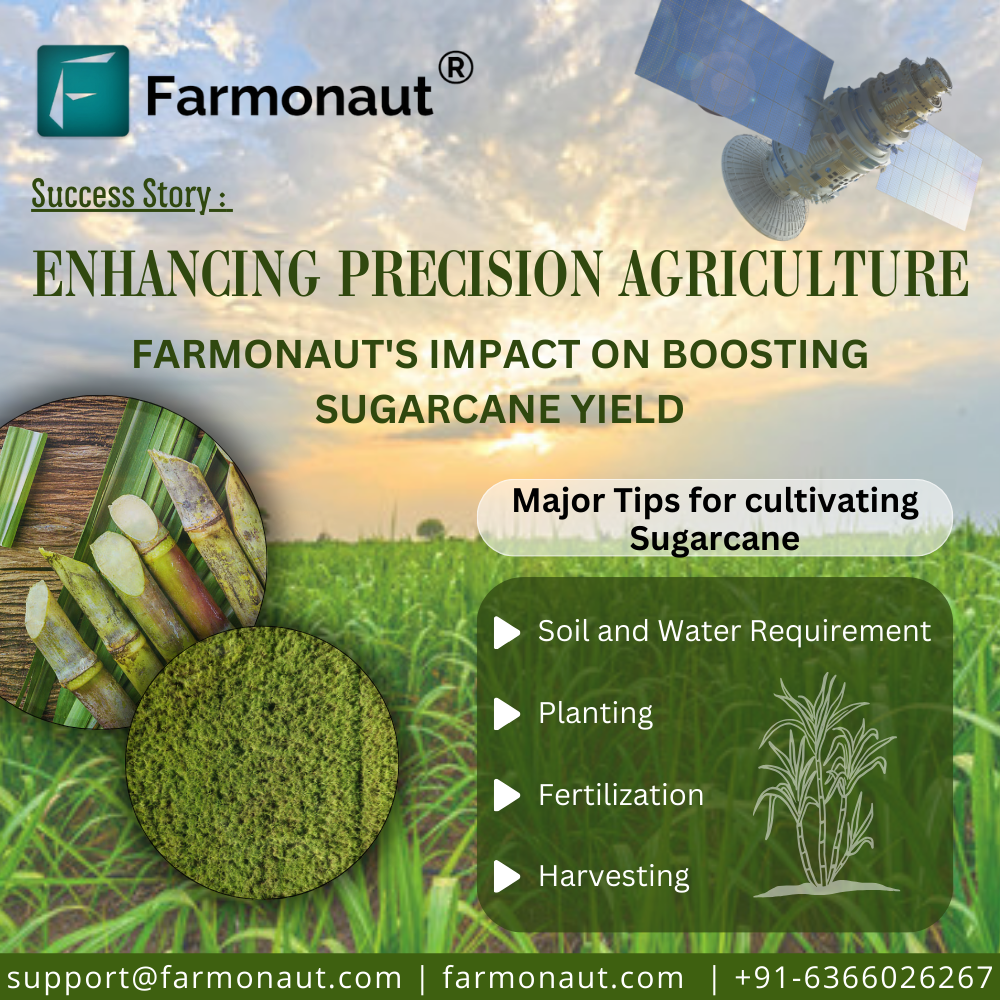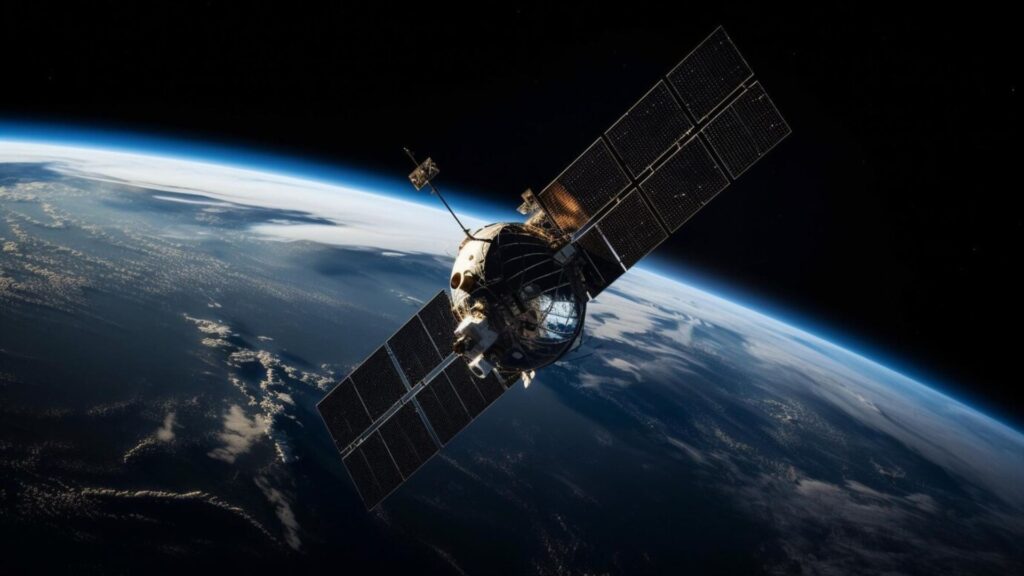Maximize Your Farm’s Potential: A Guide to Digital Agriculture Equipment Compatibility and Data Integration
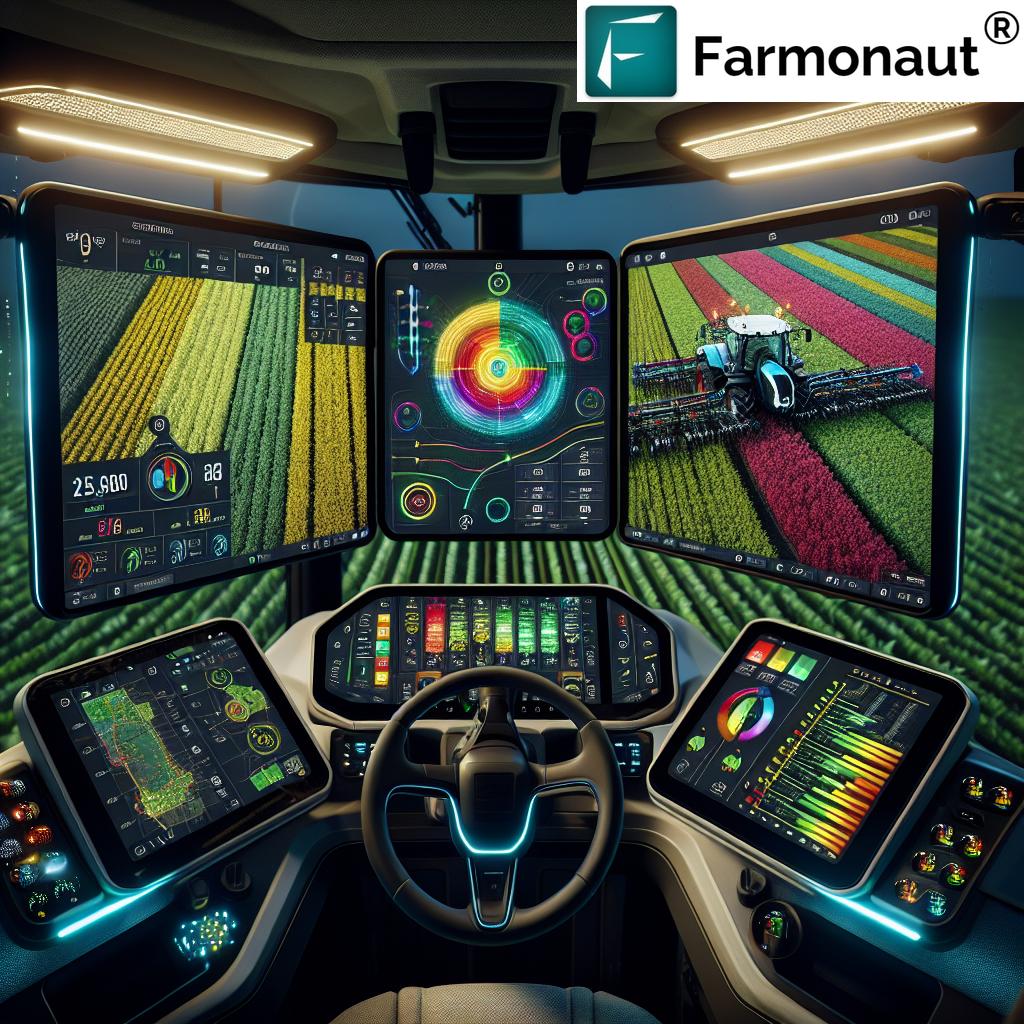
“Digital agriculture equipment can improve crop yields by up to 20% through precise planting and input optimization.”
In today’s rapidly evolving agricultural landscape, digital agriculture equipment compatibility and farm data integration are revolutionizing modern farming practices. As we delve into this comprehensive guide, we’ll explore how these innovative technologies are transforming the way we approach farming, helping to maximize yields, optimize resources, and make data-driven decisions that can significantly impact your farm’s potential.
At Farmonaut, we understand the importance of staying ahead in the digital agriculture revolution. Our platform is designed to seamlessly integrate with various digital agriculture equipment, providing farmers with powerful tools for precision farming and data analysis. Let’s embark on this journey to unlock the full potential of your farm through the power of technology and innovation.
The Role of Precision Agriculture Technology in Modern Farming
Precision agriculture technology is at the heart of the digital farming revolution. It encompasses a wide range of tools and techniques that allow farmers to make more informed decisions about their crops and land management. By leveraging advanced sensors, GPS technology, and data analytics, precision agriculture enables farmers to:
- Optimize planting patterns and seed placement
- Apply fertilizers and pesticides with pinpoint accuracy
- Monitor crop health in real-time
- Conserve water through targeted irrigation
- Reduce environmental impact by minimizing chemical use
The integration of these technologies not only improves efficiency but also contributes to sustainable farming practices. As we continue to face global challenges such as climate change and food security, the role of precision agriculture becomes increasingly crucial.
Crop Data Collection Systems: The Foundation of Smart Farming
Crop data collection systems form the backbone of digital agriculture. These systems gather crucial information about your fields, crops, and environmental conditions. Modern data collection tools include:
- Soil sensors for moisture and nutrient levels
- Weather stations for localized climate data
- Drones and satellite imagery for aerial crop health assessment
- IoT devices for real-time monitoring of field conditions
At Farmonaut, we specialize in satellite-based crop health monitoring, providing farmers with valuable insights into vegetation health (NDVI), soil moisture levels, and other critical metrics. Our advanced crop data collection systems help you make informed decisions about irrigation, fertilizer usage, and pest management, ultimately optimizing crop yields and reducing resource wastage.
Field Mapping Software: Visualizing Your Farm’s Potential
Field mapping software is an essential tool for modern farmers. It allows you to create detailed, interactive maps of your farmland, providing a visual representation of various data points such as:
- Soil composition and quality
- Crop yield variations
- Drainage patterns
- Topography and elevation
These maps serve as a foundation for implementing precision agriculture techniques. By understanding the unique characteristics of each part of your field, you can make more targeted decisions about planting, fertilization, and pest control.
Variable Rate Planting Technology: Precision in Every Seed
Variable rate planting technology represents a significant leap forward in farming efficiency. This innovative approach allows farmers to adjust seeding rates on-the-go, based on soil conditions, moisture levels, and historical yield data. The benefits of variable rate planting include:
- Optimized seed placement for maximum yield potential
- Reduced seed waste in low-productivity areas
- Improved crop uniformity across fields
- Better utilization of soil resources
By integrating variable rate planting technology with your farm management information system, you can create a data-driven approach to seeding that maximizes your farm’s potential while minimizing input costs.
Agricultural Equipment GPS Calibration: Precision on the Move
Agricultural equipment GPS calibration is crucial for ensuring the accuracy of your precision farming operations. Proper calibration of GPS systems on tractors, planters, and combines allows for:
- Precise navigation and auto-steering
- Accurate implementation of variable rate applications
- Reduced overlap and skips during field operations
- Consistent performance across different equipment and operators
Regular calibration of your GPS equipment is essential to maintain the high level of precision required for modern farming practices. At Farmonaut, we understand the importance of accurate positioning and offer solutions that seamlessly integrate with your GPS-enabled equipment.
“Over 70% of modern tractors and combines are equipped with GPS technology for centimeter-level accuracy in field operations.”
Farm Management Information Systems: The Brain of Your Digital Farm
Farm management information systems (FMIS) serve as the central hub for all your farm data and operations. These sophisticated platforms allow you to:
- Collect and analyze data from various sources
- Plan and track field operations
- Manage inventory and resources
- Generate reports and insights for decision-making
An effective FMIS should be able to integrate seamlessly with your digital agriculture equipment, creating a unified ecosystem that streamlines your farm management processes. Farmonaut’s platform is designed to work in harmony with various FMIS, enhancing your ability to make data-driven decisions and optimize your farm’s performance.
Precision Farming Data Analysis: Turning Information into Action
Precision farming data analysis is the key to unlocking the full potential of your digital agriculture equipment. By leveraging advanced analytics tools, you can:
- Identify patterns and trends in crop performance
- Predict potential issues before they become problems
- Optimize input applications based on historical data
- Make informed decisions about crop rotation and variety selection
Farmonaut’s AI-driven personalized farm advisory tool, Jeevn AI, takes precision farming data analysis to the next level. By analyzing satellite data and other inputs, Jeevn AI generates customized advice to improve farm productivity and efficiency.
Smart Farming Equipment Connectivity: Building a Unified System
Smart farming equipment connectivity is essential for creating a cohesive digital agriculture ecosystem. When your equipment can communicate seamlessly, you benefit from:
- Real-time data sharing between different machines
- Automated task coordination across your fleet
- Simplified data collection and analysis
- Improved overall farm efficiency
Ensuring compatibility between different brands and models of equipment can be challenging, but it’s crucial for maximizing the benefits of your digital agriculture investments. Farmonaut’s platform is designed to work with a wide range of equipment, helping to bridge compatibility gaps and create a more unified farming system.
Digital Agriculture Equipment Compatibility Matrix
| Equipment Category | Brand/Model | GPS Sync | Data Transfer | Real-time Monitoring | Data Integration Complexity | Key Benefits |
|---|---|---|---|---|---|---|
| Tractors | John Deere 8R Series | Fully Compatible | Fully Compatible | Fully Compatible | Low | Fuel efficiency, Precision steering |
| Planters | Case IH Early Riser 2150 | Fully Compatible | Partially Compatible | Fully Compatible | Medium | Precise seed placement, Variable rate planting |
| Combines | New Holland CR Series | Fully Compatible | Fully Compatible | Partially Compatible | Medium | Yield mapping, Harvest optimization |
| Mobile Devices | iPad Pro | Fully Compatible | Fully Compatible | Fully Compatible | Low | In-field data access, Remote monitoring |
| Drones | DJI Phantom 4 RTK | Fully Compatible | Partially Compatible | Fully Compatible | High | Aerial imagery, Crop health assessment |
This compatibility matrix provides a quick overview of how different equipment categories integrate with digital agriculture systems. It’s important to note that compatibility can vary depending on specific software versions and configurations. Always consult with your equipment manufacturer and digital agriculture service provider for the most up-to-date compatibility information.
Preparing Your Digital Tools for the Growing Season
As you prepare for the upcoming planting season, it’s crucial to ensure that all your digital agriculture equipment is ready to perform at its best. Here’s a pre-planting checklist to help you get started:
- Update all software and firmware on your equipment and devices
- Calibrate GPS systems on tractors, planters, and other machinery
- Verify connectivity between all components of your digital agriculture ecosystem
- Test data transfer capabilities between equipment and your farm management information system
- Review and update your field maps and management zones
- Check the functionality of all sensors and monitoring devices
- Ensure your mobile devices are properly set up with the latest farm management apps
By taking the time to prepare your digital tools, you’ll be setting yourself up for a successful growing season with minimal technical hiccups.
Maximizing Equipment Performance Through Data-Driven Decisions
One of the key advantages of digital agriculture is the ability to make data-driven decisions that optimize equipment performance. By analyzing the data collected from your digital agriculture equipment, you can:
- Identify inefficiencies in your operations and address them proactively
- Schedule maintenance based on actual usage rather than arbitrary time intervals
- Optimize equipment settings for specific field conditions
- Track and improve operator performance
Farmonaut’s platform provides powerful analytics tools that help you interpret your farm data and translate it into actionable insights. By leveraging these insights, you can ensure that your equipment is always operating at peak efficiency.
Integrating Mobile Devices with In-Cab Hardware
The integration of mobile devices with in-cab hardware is a game-changer for real-time field data visualization and analysis. This powerful combination allows you to:
- Access real-time data and make on-the-spot decisions
- Visualize field maps and equipment performance metrics
- Receive alerts and notifications about potential issues
- Update task lists and equipment settings remotely
Farmonaut’s mobile app is designed to work seamlessly with various in-cab systems, providing you with a user-friendly interface to access and interact with your farm data on the go. This integration ensures that you always have the information you need at your fingertips, whether you’re in the field or in the office.
The Future of Digital Agriculture Equipment Compatibility
As we look to the future, the trend towards greater compatibility and integration in digital agriculture equipment is clear. We can expect to see:
- Increased standardization of data formats and communication protocols
- More plug-and-play solutions for equipment from different manufacturers
- Advanced AI and machine learning capabilities built into farm equipment
- Enhanced connectivity through 5G and satellite internet technologies
- Greater emphasis on cybersecurity to protect farm data
At Farmonaut, we’re committed to staying at the forefront of these developments, continually updating our platform to ensure compatibility with the latest digital agriculture equipment and technologies.
Harnessing the Power of Precision Farming Data Analysis
The true power of digital agriculture lies in the ability to analyze and act on the vast amounts of data collected. Precision farming data analysis allows you to:
- Identify trends and patterns that may not be visible to the naked eye
- Make more accurate predictions about crop yields and potential issues
- Optimize input applications for maximum efficiency and yield
- Conduct detailed cost-benefit analyses of different farming practices
Farmonaut’s advanced analytics tools, including our AI-powered Jeevn AI system, are designed to help you extract maximum value from your farm data. By turning raw data into actionable insights, we empower you to make informed decisions that can significantly impact your farm’s profitability and sustainability.
For developers looking to integrate Farmonaut’s powerful satellite and weather data into their own systems, we offer a comprehensive API. Visit our API page and check out our API Developer Docs for more information.
Conclusion: Embracing the Digital Agriculture Revolution
As we’ve explored throughout this guide, digital agriculture equipment compatibility and farm data integration are transforming the way we approach farming. By embracing these technologies and ensuring seamless integration between your equipment and data systems, you can unlock new levels of efficiency, productivity, and sustainability on your farm.
Farmonaut is here to support you on this journey, offering cutting-edge solutions that work in harmony with your existing equipment and processes. Our platform is designed to grow and adapt with your needs, ensuring that you’re always at the forefront of the digital agriculture revolution.
Remember, the key to maximizing your farm’s potential lies in the smart application of technology and data-driven decision-making. By leveraging the power of digital agriculture equipment compatibility and farm data integration, you’re not just farming for today – you’re building a more resilient and productive agricultural future.
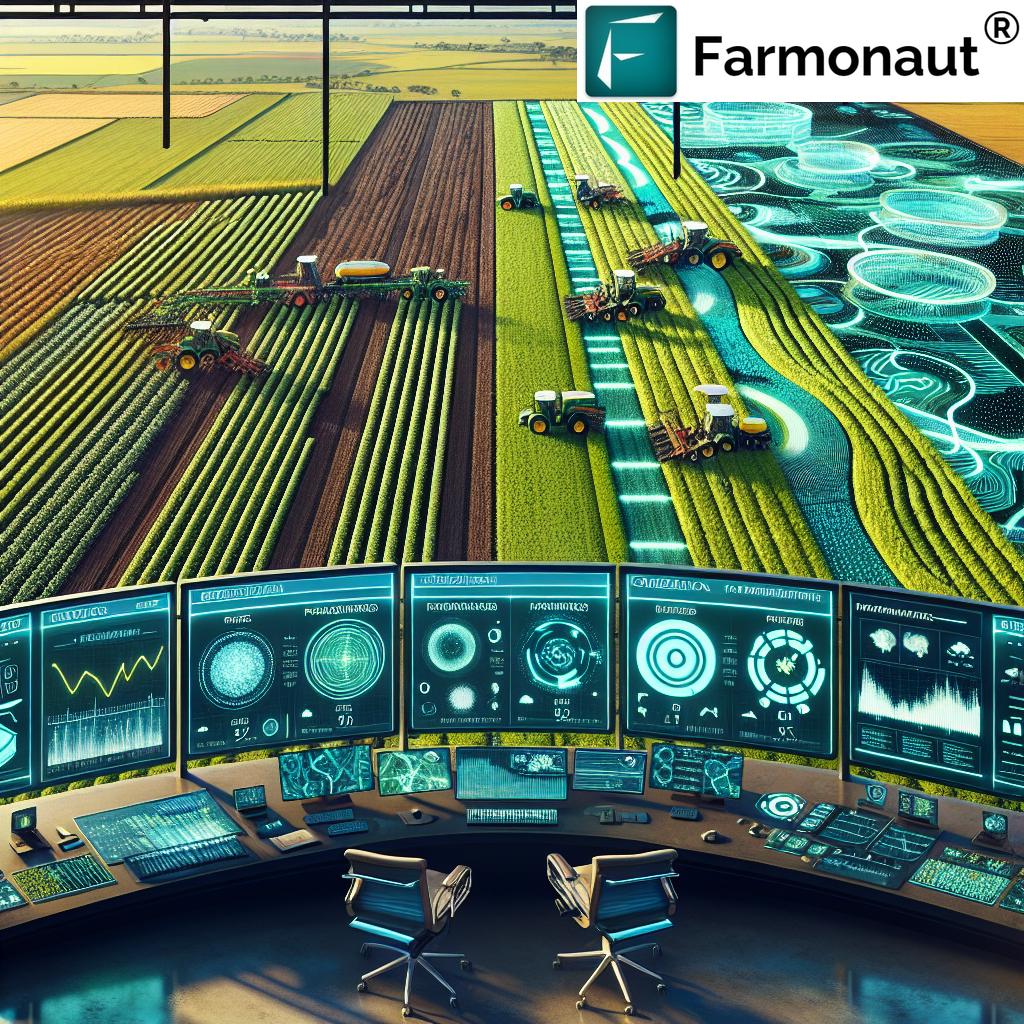
FAQ Section
Q: What is digital agriculture equipment compatibility?
A: Digital agriculture equipment compatibility refers to the ability of various farm machines, sensors, and software systems to work together seamlessly, sharing data and coordinating operations to improve overall farm efficiency and productivity.
Q: How does farm data integration benefit farmers?
A: Farm data integration allows farmers to combine information from multiple sources (e.g., equipment sensors, weather stations, satellite imagery) to gain comprehensive insights into their operations. This integrated approach enables more informed decision-making, leading to optimized resource use, improved crop yields, and increased profitability.
Q: What types of digital agriculture equipment are commonly used?
A: Common types of digital agriculture equipment include GPS-enabled tractors and implements, variable rate planters and sprayers, drones for aerial imaging, soil sensors, weather stations, and mobile devices for in-field data access and management.
Q: How can I ensure my existing equipment is compatible with new digital agriculture technologies?
A: To ensure compatibility, start by checking with your equipment manufacturer for any available software updates or retrofit options. Consider using universal data platforms or middleware solutions that can bridge gaps between different systems. Farmonaut’s platform is designed to work with a wide range of equipment, helping to improve overall compatibility.
Q: What role does precision farming data analysis play in modern agriculture?
A: Precision farming data analysis is crucial for extracting actionable insights from the vast amounts of data collected on the farm. It helps identify patterns, predict outcomes, and optimize operations, enabling farmers to make data-driven decisions that improve efficiency, reduce costs, and increase yields.
Farmonaut Subscriptions





